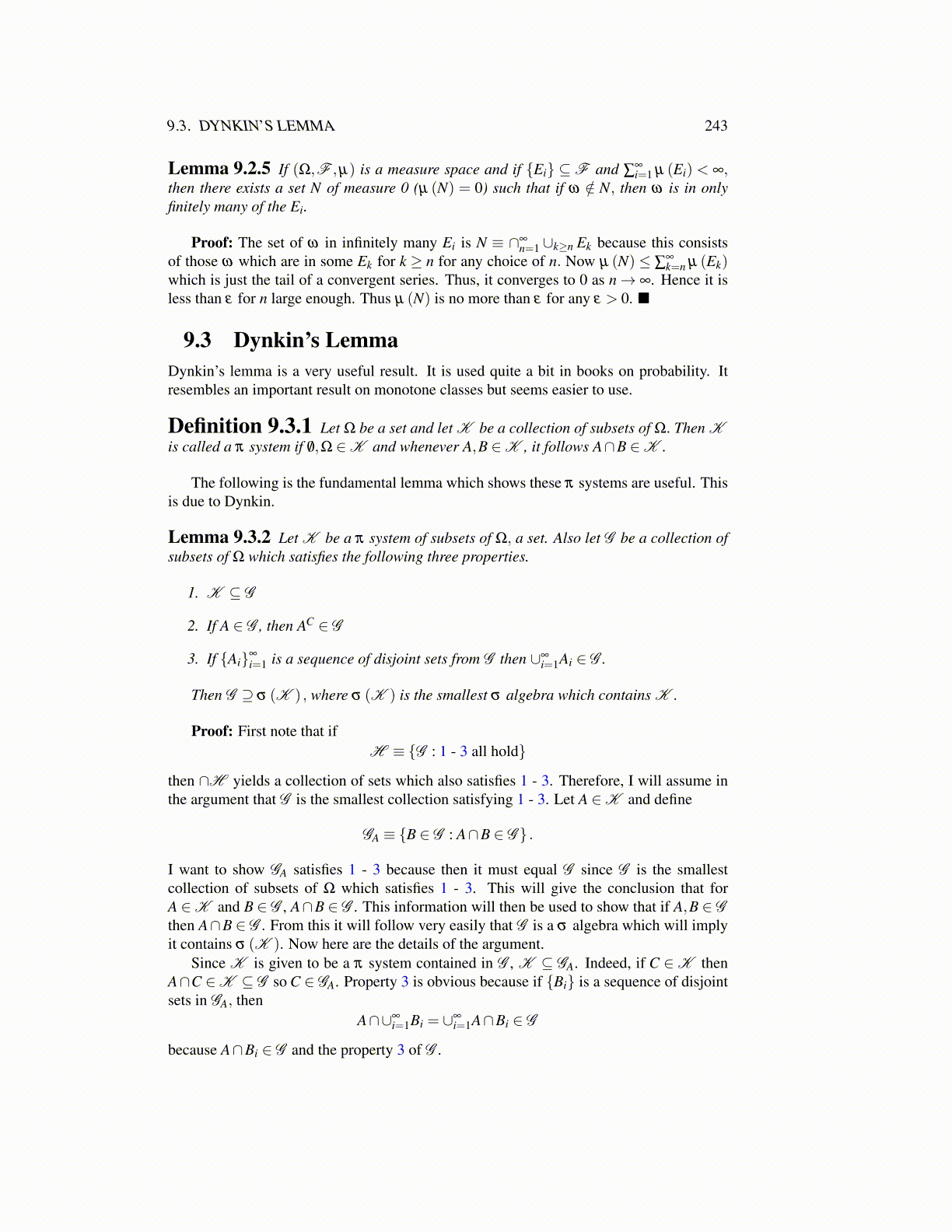
9.3. DYNKIN’S LEMMA 243
Lemma 9.2.5 If (Ω,F ,µ) is a measure space and if {Ei} ⊆F and ∑∞i=1 µ (Ei) < ∞,
then there exists a set N of measure 0 (µ (N) = 0) such that if ω /∈ N, then ω is in onlyfinitely many of the Ei.
Proof: The set of ω in infinitely many Ei is N ≡ ∩∞n=1 ∪k≥n Ek because this consists
of those ω which are in some Ek for k ≥ n for any choice of n. Now µ (N) ≤ ∑∞k=n µ (Ek)
which is just the tail of a convergent series. Thus, it converges to 0 as n→ ∞. Hence it isless than ε for n large enough. Thus µ (N) is no more than ε for any ε > 0. ■
9.3 Dynkin’s LemmaDynkin’s lemma is a very useful result. It is used quite a bit in books on probability. Itresembles an important result on monotone classes but seems easier to use.
Definition 9.3.1 Let Ω be a set and let K be a collection of subsets of Ω. Then Kis called a π system if /0,Ω ∈K and whenever A,B ∈K , it follows A∩B ∈K .
The following is the fundamental lemma which shows these π systems are useful. Thisis due to Dynkin.
Lemma 9.3.2 Let K be a π system of subsets of Ω, a set. Also let G be a collection ofsubsets of Ω which satisfies the following three properties.
1. K ⊆ G
2. If A ∈ G , then AC ∈ G
3. If {Ai}∞
i=1 is a sequence of disjoint sets from G then ∪∞i=1Ai ∈ G .
Then G ⊇ σ (K ) , where σ (K ) is the smallest σ algebra which contains K .
Proof: First note that ifH ≡ {G : 1 - 3 all hold}
then ∩H yields a collection of sets which also satisfies 1 - 3. Therefore, I will assume inthe argument that G is the smallest collection satisfying 1 - 3. Let A ∈K and define
GA ≡ {B ∈ G : A∩B ∈ G } .
I want to show GA satisfies 1 - 3 because then it must equal G since G is the smallestcollection of subsets of Ω which satisfies 1 - 3. This will give the conclusion that forA ∈K and B ∈ G , A∩B ∈ G . This information will then be used to show that if A,B ∈ Gthen A∩B ∈ G . From this it will follow very easily that G is a σ algebra which will implyit contains σ (K ). Now here are the details of the argument.
Since K is given to be a π system contained in G , K ⊆ GA. Indeed, if C ∈K thenA∩C ∈K ⊆ G so C ∈ GA. Property 3 is obvious because if {Bi} is a sequence of disjointsets in GA, then
A∩∪∞i=1Bi = ∪∞
i=1A∩Bi ∈ G
because A∩Bi ∈ G and the property 3 of G .